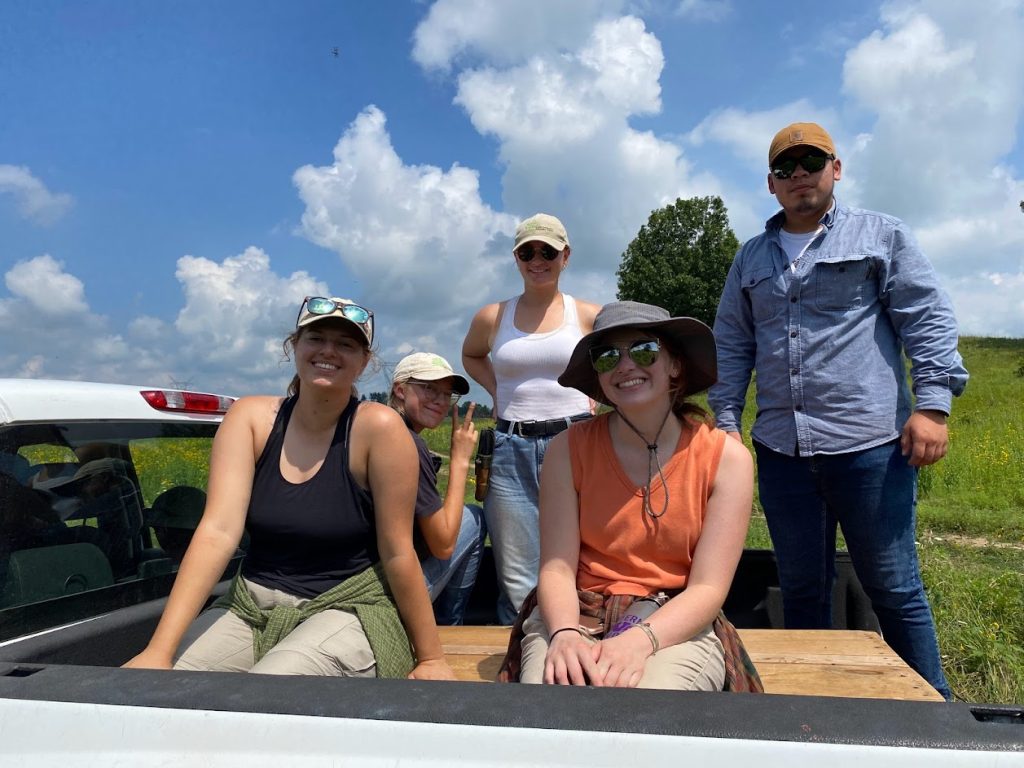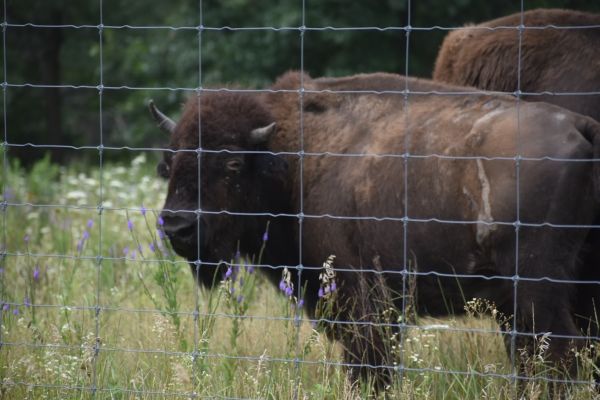
Bison, native plant gardens, first aid and more – CLIP Week 10
by Breanna Christensen
To begin the week we spent Monday morning meeting on Zoom for a Conservation Career Panel. We met with multiple people CLIP Director Kim Elsenbroek knows, including Briana Whitaker, Natalie Christian, Dana Carpenter, Susanne Masi, Audrey Pangallo and Aarin Wilde. By speaking to them we learned a lot about their career paths, graduate schooling, typical workdays and research projects. Having the opportunity to speak to people with experience in many areas of the field helped us gain incredibly valuable insight!
 In the afternoon we met with Sarah and Scott at the McHenry County Government Center in Woodstock. There, Scott gave us a tour of the native plant garden outside of the building he manages. He also discussed ecotypes and strategies for introducing genetic diversity to native populations. After his tour, Sarah took us to her home where she showed us her beautiful native plant gardens, spreading the message of TLC’s Conservation@Home program. This program encourages people to make meaningful contributions to the environment’s health through practices that can be done at your own home. Together, Sarah and Scott’s presentations emphasized how there is a lack of native plant landscapers, and how there is an increasing need for them.
In the afternoon we met with Sarah and Scott at the McHenry County Government Center in Woodstock. There, Scott gave us a tour of the native plant garden outside of the building he manages. He also discussed ecotypes and strategies for introducing genetic diversity to native populations. After his tour, Sarah took us to her home where she showed us her beautiful native plant gardens, spreading the message of TLC’s Conservation@Home program. This program encourages people to make meaningful contributions to the environment’s health through practices that can be done at your own home. Together, Sarah and Scott’s presentations emphasized how there is a lack of native plant landscapers, and how there is an increasing need for them.

We spent Tuesday at the Wonder Lake Sedge Meadow, beginning with scouting the area for teasel and any miscellaneous white sweet clover. Half of us would clip and collect the seeding heads from the adult teasel plants to prevent them from spreading seeds. As a precaution in case the herbicide doesn’t kill the plant off in time, we also clipped nearly all of the remaining heads. Next, the other half of us would backpack spray the teasel using 3% Garlon. After our break for lunch, we took care of the remaining adult teasels, and then spent the rest of the time spraying the teasel rosettes. By the end of the day, we had MULTIPLE yard collection bags full of teasel heads! For the last bit of the day, we continued working on our research project studying the effects of herbicide on Rudbeckia triloba. The physical experiment and nearly all of our research report are complete; we’re just working on the finishing touches.
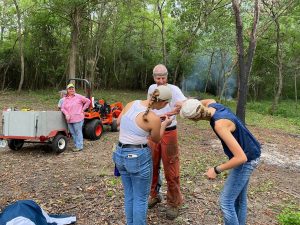

The weather forecast didn’t look good for Wednesday’s workday at Crowley Oaks. The sky was gloomy and the radar wasn’t looking promising. But together, CLIP and the workday volunteers got to work with brushing and chainsawing. Luckily, we were able to work through the whole morning with only a sprinkle of rain getting us. We spent the workday clearing lots of buckthorn, honeysuckle, and other invasives. In the midst of the commotion, our “EMS” team–Kristi and Casper–jumped in to patch up a cut on a volunteer’s arm, adorned in high-fashion EMS hats! Just from the few hours spent clearing the brush at Crowley, we could see tremendous progress. The volunteers met at Isabel’s Family Restaurant in Woodstock, treating the CLIPterns to a delicious lunch. Casper and Amelia spent the rest of the day pulling giant, and I mean really giant, ragweed at Hennen.
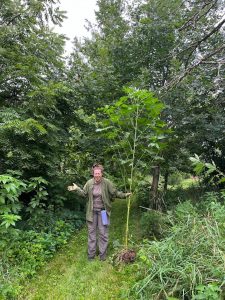
Meanwhile, Kim and I went to the Youth & Family Center of McHenry County to teach a dance class. We began by doing warmups to get our blood pumping, and then we did dance moves across the floor. Kim was teaching the kids Azonto, a type of Ghanaian dance that uses accompanying hand movements to mimic everyday activities. To emphasize ideas of environmental appreciation, we used movements like walking a dog, looking with binoculars, and paddling a boat. The kids got really into it by the end, practicing the moves in between run-throughs and hurrying to their places to perform it one last time.
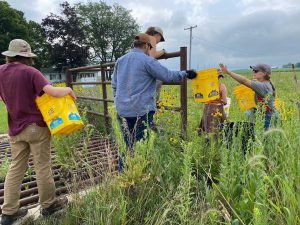 CLIP spent Thursday at Nachusa Grasslands, getting to see their remarkable prairie ecosystems. For the first half of the day, CLIP worked with one of Nachusa’s crews, led by Molly, to collect golden alexander seed from a prairie. We spread out, clipping and collecting the seeds for a couple of hours until heading back for lunch and viewing the bison corrals. Next, we were able to see their impressive seed processing building and even help prepare the golden alexander seed for drying in the barrels. It was so cool seeing their barrels of different seeds that had been fully dried and processed.
CLIP spent Thursday at Nachusa Grasslands, getting to see their remarkable prairie ecosystems. For the first half of the day, CLIP worked with one of Nachusa’s crews, led by Molly, to collect golden alexander seed from a prairie. We spread out, clipping and collecting the seeds for a couple of hours until heading back for lunch and viewing the bison corrals. Next, we were able to see their impressive seed processing building and even help prepare the golden alexander seed for drying in the barrels. It was so cool seeing their barrels of different seeds that had been fully dried and processed.

 We spent the rest of our afternoon there touring the remnant prairies and finding bison. Us CLIPterns rode on a bench in the bed of the crew’s truck where we got an amazing view of the surrounding prairies … and bison! We were able to watch a small herd of bison from the truck, and we saw even more of them from the roadside. They truly are exceptional creatures who play an important role in their habitats with their wallowing and grazing habits. Visiting Nachusa was a wonderful experience, and I’d love to go back.
We spent the rest of our afternoon there touring the remnant prairies and finding bison. Us CLIPterns rode on a bench in the bed of the crew’s truck where we got an amazing view of the surrounding prairies … and bison! We were able to watch a small herd of bison from the truck, and we saw even more of them from the roadside. They truly are exceptional creatures who play an important role in their habitats with their wallowing and grazing habits. Visiting Nachusa was a wonderful experience, and I’d love to go back.
 Friday morning was spent in Apple Creek putting up TLC signs by the property lines to enforce the rules which protect the easement. We split into teams to help one another replace any damaged or missing signs; we even raced each other to finish the final ones! At the same time, we were able to use the brush saw on the sweet clover growing about. Back at Hennen, we did some miscellaneous activities like putting away tools, taking out the garbage, and prepping some herbicide mixes. We even spent a few minutes walking about Hennen, collecting flowers to press so that we can all make our own pressed flower displays for the upcoming graduation ceremony. They’re going to look so beautiful! To finish off the week we discussed our latest reading, “Nature and Structure of the Climax” by Frederic E. Clements, a paper important to the fundamentals of ecology.
Friday morning was spent in Apple Creek putting up TLC signs by the property lines to enforce the rules which protect the easement. We split into teams to help one another replace any damaged or missing signs; we even raced each other to finish the final ones! At the same time, we were able to use the brush saw on the sweet clover growing about. Back at Hennen, we did some miscellaneous activities like putting away tools, taking out the garbage, and prepping some herbicide mixes. We even spent a few minutes walking about Hennen, collecting flowers to press so that we can all make our own pressed flower displays for the upcoming graduation ceremony. They’re going to look so beautiful! To finish off the week we discussed our latest reading, “Nature and Structure of the Climax” by Frederic E. Clements, a paper important to the fundamentals of ecology.

